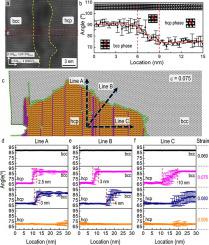当前位置:
X-MOL 学术
›
Mater. Today
›
论文详情
Our official English website, www.x-mol.net, welcomes your
feedback! (Note: you will need to create a separate account there.)
Atomic deformation mechanism and interface toughening in metastable high entropy alloy
Materials Today ( IF 21.1 ) Pub Date : 2020-07-01 , DOI: 10.1016/j.mattod.2020.02.017 Peng Wang , Yeqiang Bu , Jiabin Liu , Qianqian Li , Hongtao Wang , Wei Yang
Materials Today ( IF 21.1 ) Pub Date : 2020-07-01 , DOI: 10.1016/j.mattod.2020.02.017 Peng Wang , Yeqiang Bu , Jiabin Liu , Qianqian Li , Hongtao Wang , Wei Yang

|
Abstract Metastable high entropy alloy (HEA) with excellent properties have attracted extensive attentions recently. However, as a consequence of limited experiments of high-resolution transmission electron microscopy (HRTEM) and the difficulties of molecular dynamic (MD) simulations for the phase transformation process, the detailed atomic deformation mechanisms in the HEA is not well understood. We carry out the in situ HRTEM observation of the martensitic transformation process and find surprisingly wide phase interface between the parent and the martensite in a typical high strength and high elongation metastable HEA. One specific interatomic potential is developed for the metastable HEA and large-scale MD simulation is carried out to investigate the martensitic transformation process from body-centered cubic to hexagonal close packed structures. The whole processes of the stress-induced martensitic transformation (nucleation, incubation, bursting and propagating of the new phase) are well reproduced in the MD simulations, suggesting its good agreements with the HRTEM observations. The width of the phase interface mainly depends on the competition between interfacial energy and lattice distortion energy during the martensitic transformation process. This wide phase interface acts as a buffer to coordinate the martensitic transformation induced strain and as a buffer storage for dislocation gliding and pile-up. As a result, the metastable HEA achieves a high strength combined with a large tensile elongation. The revealed atomic-scale deformation and corresponding interatomic potential should be useful to guide the design in the new series of high-performance metastable alloy.
中文翻译:

亚稳态高熵合金的原子变形机制与界面增韧
摘要 近年来,具有优异性能的亚稳态高熵合金(HEA)受到了广泛的关注。然而,由于高分辨率透射电子显微镜 (HRTEM) 的实验有限以及相变过程的分子动力学 (MD) 模拟的困难,HEA 中详细的原子变形机制尚不清楚。我们对马氏体转变过程进行了原位 HRTEM 观察,并在典型的高强度和高伸长率亚稳态 HEA 中发现了母体和马氏体之间令人惊讶的宽相界面。为亚稳态 HEA 开发了一种特定的原子间势,并进行了大规模的 MD 模拟,以研究从体心立方体到六方密堆积结构的马氏体转变过程。在 MD 模拟中很好地再现了应力诱导的马氏体转变(新相的成核、孵化、爆裂和传播)的整个过程,表明其与 HRTEM 观察结果非常吻合。相界面的宽度主要取决于马氏体相变过程中界面能和晶格畸变能之间的竞争。这种宽相界面作为缓冲来协调马氏体转变引起的应变,并作为位错滑动和堆积的缓冲存储器。因此,亚稳态 HEA 实现了高强度和大拉伸伸长率。揭示的原子尺度变形和相应的原子间势应有助于指导新系列高性能亚稳态合金的设计。
更新日期:2020-07-01
中文翻译:

亚稳态高熵合金的原子变形机制与界面增韧
摘要 近年来,具有优异性能的亚稳态高熵合金(HEA)受到了广泛的关注。然而,由于高分辨率透射电子显微镜 (HRTEM) 的实验有限以及相变过程的分子动力学 (MD) 模拟的困难,HEA 中详细的原子变形机制尚不清楚。我们对马氏体转变过程进行了原位 HRTEM 观察,并在典型的高强度和高伸长率亚稳态 HEA 中发现了母体和马氏体之间令人惊讶的宽相界面。为亚稳态 HEA 开发了一种特定的原子间势,并进行了大规模的 MD 模拟,以研究从体心立方体到六方密堆积结构的马氏体转变过程。在 MD 模拟中很好地再现了应力诱导的马氏体转变(新相的成核、孵化、爆裂和传播)的整个过程,表明其与 HRTEM 观察结果非常吻合。相界面的宽度主要取决于马氏体相变过程中界面能和晶格畸变能之间的竞争。这种宽相界面作为缓冲来协调马氏体转变引起的应变,并作为位错滑动和堆积的缓冲存储器。因此,亚稳态 HEA 实现了高强度和大拉伸伸长率。揭示的原子尺度变形和相应的原子间势应有助于指导新系列高性能亚稳态合金的设计。










































 京公网安备 11010802027423号
京公网安备 11010802027423号